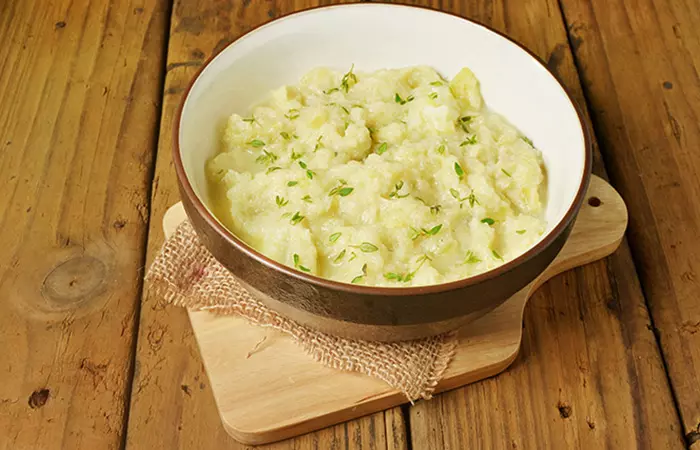Chayote squash is a fruit that is used as a vegetable. It is native to southern Mexico. It is also known as mirliton, choko, vegetable pear, and custard marrow. This squash is especially used in many cuisines all over the world for its unique savory taste and tender edible flesh. What Are Its Benefits? It helps reduce blood sugar levels, lowers blood pressure, promotes heart health, prevents kidney stones and manages hypertension. Who Can Use It? All except those who are allergic to it. How Often? Regularly, but in moderation. Caution No known side effects. Consult a doctor in case you are allergic to it.
Chayote squash has a unique mild savory flavor. It can be easily mixed with any other vegetable. Raw chayote squash tastes like an apple with a mild crunch and slightly sweet taste, and a ripe one tastes like a cucumber. A blogger tried chayote squash and shared her experience in her blog. She writes, “The squash is sweet, it reminds me of a green pepper in its texture and flavor, it is very crisp and fresh tasting it almost looks like a green apple, but it smells like earth, and it has a solid consistency that would be good in salad or even a soup…. I will be having this vegetable again because it could replace some other vegetables and switch up boring recipes (i).”
Chayote Squash Nutrition Facts
Chayote squash (100 grams) contains the following nutrients (1):
Calories: 19 Water: 94.2 grams Fat: 0.1 gram Fiber: 1.7 grams Carbohydrates: 4.5 grams Protein: 2.0 grams Vitamin C: 7.7 milligrams Vitamin E: 0.1 milligrams Vitamin B6: 0.1 milligrams Total Folate: 93 micrograms Copper: 0.1 milligrams Potassium: 125 milligrams Magnesium: 12 milligrams Phosphorus: 18 milligrams Zinc: 0.7 milligrams
This graph from a 2022 study published in Plants shows the accumulation of soluble sugars in chayote fruit varieties. Fructose accumulation was compared to glucose accumulation, and no sucrose was discovered. The average values recorded were 1.04% for fructose and 0.76% for glucose, which were comparable to the values reported for other chayote varietal groups, such as nigrum spinosum, virens levis, and nigrum xalapensis, which were 2.03 and 2.42%, respectively.
Accumulation Of Soluble Sugars In Fruits Of Chayote Squash
Thanks to these nutrients, chayote squash is known for its important benefits. We have discussed them in the next section.
Health Benefits Of Chayote Squash
1. May Help Manage Blood Glucose Levels
Similar to the benefits of squash, chayote squash is low in calories and is suitable for a low-sugar diet as it is diabetes-friendly. In a study, chayote was found to significantly reduce blood sugar levels after regular consumption (2). Research also found that the juice of chayote, when taken before a starch-rich diet, may significantly manage the rise in postprandial blood glucose levels in rats (3).
2. May Help Manage Hypertension
A study has shown that chayote squash has potassium and alkaloids (4). These exhibit diuretic properties that may help kidneys remove excess fluid and salt from the body. This effect might reduce blood pressure. In another study, the juice of chayote was found to significantly reduce hypertension in pregnant women (5). However, if you are pregnant and wanted to consume chayote for its benefits, consulting your doctor is recommended.
3. May Help Reduce The Risk Of Cardiovascular Disease
As stated, the potassium and alkaloids in chayote squash are diuretics. Research has shown that this diuretic property can reduce hypertension and prevent the hardening and calcificationi It refers to the process where calcium accumulates in body tissue and causes the tissue to harden, which could be normal or abnormal. of arteries (4). This reduces the possibility of a heart attack. As per another study, the administration of chayote juice may significantly reduce triglyceridesi Lipids or fats that are present in your blood which are either produced by your body or obtained from the diet. and LDL cholesterol and improve HDL cholesterol levels in rats (6).
4. May Help Prevent Kidney Stones
Chayote squash is rich in potassium. Research has proven that potassium exhibits diuretic properties that help eliminate the extra fluids in the kidneys and prevent the formation of kidney stones (4). You can have chayote squash juice or as raw chopped pieces in a salad. The juice from chayote leaves may also help one manage kidney stones. However, more information is warranted in this regard.
5. May Promote Skin Health
Chayote squash is rich in vitamin C. Anecdotal evidence suggests that regular consumption of chayote squash may minimize acne and dark spots. Studies show that vitamin C is a potent antioxidant that exhibits many beneficial effects on the skin (7). However, more research is needed to further determine the benefits of chayote on skin.
6. May Offer Anti-Aging Benefits
Chayote squash plants are widely used in the cosmetic, skin care, and pharmaceutical industries. Their fruit extracts were found to protect skin cells from UVA damage. They also may help reduce any harmful substances present in the skin cells (8). This way, they may possibly slow down premature aging. Around 20 to 25% of adults worldwide are believed to have metabolic syndrome (MetS), and aging is a significant factor contributing to its occurrence. Consuming chayote squash has been found to help reduce DNA damage and increase the stability of the genetic material that may help reduce the signs of aging. The squash also contains antioxidants and has anti-inflammatory properties that help manage metabolic syndrome and the associated issues with aging (9). You can include chayote in your regular diet to reap its benefits. Now that we have discussed how chayote benefits your skin and health, let us look at a few tasty and healthy recipes using chayote.
5 Easy And Tasty Recipes With Chayote
1. Chayote Gratin
What You Need
1 medium chayote squash 150 grams cheese 2 teaspoons butter 2 small onions 4 crushed garlic cloves 1 cup fresh cream 1 teaspoon salt 1 teaspoon chopped cilantro
Method
2. Stir-Fried Chayote
What You Need
1 medium chayote 5 tablespoons butter ½ tablespoon minced ginger 3 crushed garlic cloves 1 tablespoon chili flakes ½ tablespoon mustard seeds ½ tablespoon cumin seeds 1 tablespoon salt
Method
3. Pickled Chayote
What You Need
1 medium chayote 2 small onions 1 medium garlic 1 tablespoon whole black peppercorns 1 tablespoon salt 2 cups white vinegar ¾ cups granulated white sugar
Method
4. Stuffed Chayote
What You Need
2 medium chayotes 2 medium onions, minced 2 tablespoons butter 1 tablespoon salt ½ tablespoon pepper 2 eggs, beaten 200 grams cheese 150 grams minced meat 1 cup sweet corn
Method
5. Chayote Coconut Milk Soup
What You Need
1 medium chayote 150 grams beans 100 grams cabbage 5 tablespoons crushed ginger 1 large onion 2 tablespoons butter 1 cup coconut milk 1 ½ teaspoon sugar 2 tablespoons lemon juice ½ tablespoon salt ¼ teaspoon pepper 2 sliced red chilies 1 cup vegetable broth
Method The high water content in chayote squash makes it prone to spoilage. Proper storage can enhance its shelf-life. Effective storage methods are discussed in the next section.
How Do I Store Chayote?
Chayote can be stored in a refrigerator for 3 weeks. Wipe chayote with a dry cloth. Wrap it in a thin cotton cloth and place it in a plastic bag. Do not freeze chayote. If you observe any spots or molds, discard the squash as it may be rotten and unfit for consumption.
Can Chayote Squash Interact with Any Medications?
To date, there are no known interactions of chayote squash with any medications. It is a low-calorie and nutrient-dense food and suitable for regular consumption unless one is allergic to it. However, consult your doctor before eating chayote if you are on any medications. Is chayote high in uric acid? No. But the purinei It refers to the natural, white, crystalline chemical compounds in foods and is produced naturally by the body. found in chayote can increase uric acid levels in the blood. Can chayote cause anemia? No. On the other hand, chayote contains vitamin B12 and iron, which may prevent and manage anemia. Should you boil chayote? You can prepare chayote in any way you prefer. It can be boiled, steamed, or grilled. It depends on the dish you are making. Is chayote easy to digest? As discussed above, chayote has a high amount of fiber. Therefore, it may be easy to digest. Is it OK to eat chayote skin? Yes, it is okay to eat chayote skin as all its parts are edible. However, you can remove it with a peeler if you do not want to eat it. Is chayote similar to zucchini? Chayote and zucchini belong to the same gourd family and can be used as substitutes for each other. Zucchini has many benefits just like chayote. However, the flavor of zucchini is stronger with a slightly softer texture and higher water content than chayote. Are chayote and green papaya the same? Though identical, these two are not the same. However, they can be prepared the same way and have the same texture when cooked. Explore the nutritional benefits of chayote. Watch this video to learn more about how this wholesome vegetable can improve your overall health and well-being.












